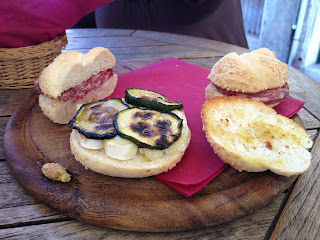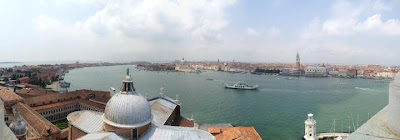European
restaurants, along with local businesses, are very schizophrenic when
it comes to their hours. Take, for example, Trattoria Dai Tosi, the wonderful, locals-only restaurant a few feet from our B&B. They served up a full menu and pizza but only in the following manner. Monday, Tuesday, and Thursday they served only the full menu at lunch but no pizza. At night, they served pizza but no full menu. Friday-Sunday, they served pizza during the day and full menu at night. Friday and Saturday, they also served pizza at night, but not on Sunday. Wednesday they were closed. Who can keep up!?
For our first night in Italy, we ate at Trattoria Dai Tosi upon the recommendation of our host at the B&B. Despite showing up at 7 o'clock to
an entirely empty restaurant, they were nearly going to refuse to seat
us due to lack of reservations. Graciously, our B&B host talked
them into letting us sit and eat, as he forgot to call in a reservation
for us. Despite our noblest attempts at Italian, the waiter spoke
perfect English and helped us through the local customs and selections.
He was the one who explain the spritz spectrum to us and suggested the
one with Aperol. He also advised me to order a different prosciutto plate than the one I asked for, as it was typically given
to little children. I should note that the menu was only in Italian.
As
I've said many times before, I don't usually eat meat, but will make an
exception when warranted. Most, if not all of the meat like this is
from animals who roam the countryside free range or totally wild. The
animals are treated humanely and the quality of the meat is
unsurpassed. That being said, I acknowledge that it's a big plate of
slimy pork. But it was really good! The flavor was very mild yet deeply
complex. It was also super light and I didn't feel disgusting after
eating it all. We also got a mixed salad that you can see in the
distance and below.
We
went simple for our main courses: Penne Pomodoro and Spaghetti al
Ragu. The Pomodoro was a simple tomato sauce, yet its flavor was
nothing simple. It was rich and delicious and perfectly executed. I
sat for a few minutes studying it to figure out how they make something
so simple taste so good. I could only conclude that it was the quality
of the tomato sauce being used.
The
al Ragu sauce was a simple meat sauce that might otherwise be called
Bolognese sauce or something similar. It was also perfectly executed
and had a ton of savory flavor packed into its appropriately
proportioned amount. What I mean by that is the sauce is cooked up with
the pasta and becomes one with it. It's never a huge ladle-full dumped
on top at the end. This is how pasta and sauce are supposed to be
served.

Another night in Venice brought us to a slightly more upscale restaurant
called Il Nuovo Galeon, which was situated on Via Garibaldi, just a few
minutes from our B&B. It looked inviting, the menu looked tasty,
and the waiter was a very charming old Italian man who spoke very good,
though heavily-accented, yet highly amusing English. We started simply
enough with two pasta dishes and a half bottle of wine (PORTION
OPTIONS!). I ordered the penne al'arrabiata and my wife ordered the
penne quatro formaggio (grown up mac n cheese). Hers was pretty good,
but mine was outstanding. This dish of pasta was easily one of the best
I've had, with the penne perfectly al dente and the sauce oh-so
perfect. Again, notice how it's just cooked in with the pasta; it's not
drowning it. Arrabiata sauce is supposed to be a bit spicier than
regular pomodoro sauce, but this one was just plain delicious. I didn't
detect too much spice, but there was a ton of flavor. The paremsan
cheese certainly helped (and was oddly pre-applied to the pasta when it
was served). As you can tell from the photo, this portion of pasta
isn't very large. That's because it's only a primi piatti, or first
dish. You're supposed to order more food for your secondi. Since I was
still hungry and feeling adventurous, I asked the waiter to recommend
something local and traditional. Enter the Fritto Misto.
Fritto
Misto is a plate of various, mixed seafood from the Venetian lagoon
lightly fried and served with a slice of lemon. I'm well aware that
I've lambasted similar plates of deep fried everything on this blog,
most recently in the review of Blue Water Bay. However, look at this
plate. Notice how reasonably sized it is. I will add that the food was
very lightly fried. Mostly, the flavor of the fresh fish dominated, as
opposed to the batter and grease that typically do here in the States.
What you have on this wonderful plate is sardines, shrimp, calamari,
seaweed, and one thing I'm not quite sure of (it's the wider strips
towards the bottom). It was fantastic. The shrimp had a rich flavor
and light fluffy texture that I didn't know were possible from a shrimp.
The calamari was to die for. I think squid and octopus are marvels of
nature and am generally opposed to eating them. This was the one
exception I could justify. It was local, it was sea raised, and it was
delicious. The sardines were very fishy and not terribly pleasant. I
forced myself to eat them, however, as I believe I have to eat the once
living creature that I ordered no matter what.
Another option for those with smaller appetites is the cicchetti (bar finger food) that you could order with some drinks. Each place serves something different, and to be honest, most of them weren't worth getting. At our favorite bar, El Refolo on Via Garibaldi, however, they served up delicious little sandwiches that they made in house for only 2 euro each. Pictured above is zucchini with brie and salami. The little breads were lightly toasted and served very quickly. One night, we just made our dinner out of these, along with a few spritzes each for only 20 euro (4 sandwiches, 4 drinks).
Even though I've already spent most of my time indiscriminately buying every piece of food that looks interesting or delicious, I do try to make some choices that will help the budget rather than dig us deeper. For example, pizza night can be a wonderful dining option when you're looking to eat on the cheap. We returned to Trattoria Dai Tosi for take out pizza (we didn't want to deal with the lack of reservations again). What we ended up with was a wonderful dinner al fresco with a box of delicious funghi pizza and a bottle of Verona wine. It was excellent pizza, excellent wine, and we were eating right by the water, staring out at the lagoon as the sun set. Why pay a ton of money to do this at a restaurant when you can do it for 17 euro?
I'll close the Italian section with something sweet: gelato. We sampled many wonderful flavors across the city and region (pistachio, dark cherry, tiramisu), but the one below was by far my favorite. Grom is known as one of the best gelatiers, using organic ingredients and creating unusual flavor combinations. Typically, I order the stupidest thing on the menu when at an ice cream establishment (Triple fudge brownie with butterfinger cone topped with jelly beans, sprinkles, strawberries, caramel, and wasabi peas). In fact, I'm known for my poor decision making when faced with a dessert decisions. Over the years, however, I've reigned in my enthusiasm and learned to make smarter choices. So, on a warm June afternoon in Padova, milk and mint was the selection to be made. It was outstanding. It wasn't quite vanilla based, but was simply light and creamy and minty fresh! We also got the double dark chocolate and would mix bites into a delicious combination.

So, there you have my Italian entry into the travel food blog. If you thought this was good, wait till you see/read about France!

























 Venice from the top of the San Georgio Campanile
Venice from the top of the San Georgio Campanile
